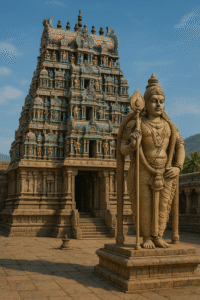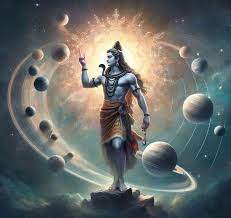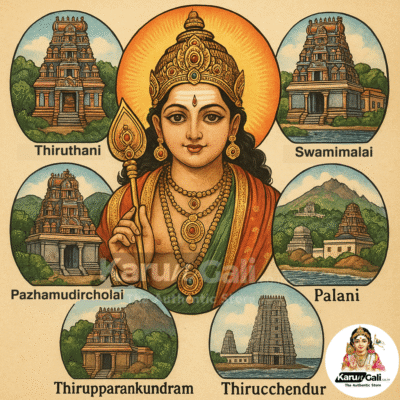Arupadai Veedu stands as one of the most significant pilgrimage circuits in Tamil Nadu, representing the six sacred abodes of Lord Murugan that have drawn millions of devotees for centuries. These divine sanctuaries, collectively known as the Six Abodes of Murugan, form the spiritual heart of Tamil devotion to the beloved deity who represents valor, wisdom, and divine grace.
Understanding Arupadai Veedu: The Sacred Foundation
The term Arupadai Veedu literally translates to “six army houses” or “six battle camps,” referring to the six temples dedicated to Lord Murugan across Tamil Nadu. These temples depict Murugan as a warrior-god and are also known as Thirumurugatrupadai. The six sacred locations are:
- Thiruparankundram – Located near Madurai
- Tiruchendur – Situated on the Bay of Bengal coast
- Palani – Perched atop the Palani Hills
- Swamimalai – Near Kumbakonam
- Thiruthani – Close to Chennai
- Pazhamudircholai – In the hills near Madurai
These temples date back to the 2nd century and represent different aspects of Lord Murugan’s divine manifestations. Each temple is associated with unique legends, architectural marvels, and spiritual significance that collectively form the foundation of Tamil Hindu devotion.
The Divine Legend Behind Arupadai Veedu
 The legend of Murugan is beautifully described in the Skanda Puranam, the Tamil iteration of the Skanda Purana. According to this sacred text, the demon Surapadman drove the devas out of heaven, prompting them to seek help from Lord Vishnu and Brahma. These deities assigned Kamadeva to disturb Lord Shiva from his meditation and unite him with Goddess Parvati. From this divine union, Lord Murugan was born.
The legend of Murugan is beautifully described in the Skanda Puranam, the Tamil iteration of the Skanda Purana. According to this sacred text, the demon Surapadman drove the devas out of heaven, prompting them to seek help from Lord Vishnu and Brahma. These deities assigned Kamadeva to disturb Lord Shiva from his meditation and unite him with Goddess Parvati. From this divine union, Lord Murugan was born.
Murugan was appointed as the commander of the devas and successfully defeated Surapadman in battle, restoring peace to the heavens. The victory over evil forces is commemorated through the Arupadai Veedu temples, each marking significant events in Murugan’s divine journey. After the war, Murugan married the goddesses Valli and Devasena, events that are celebrated at specific temples within the circuit.
Literary Significance and Ancient References
The Arupadai Veedu temples hold immense importance in Tamil literature and have been celebrated for over two millennia. The most significant literary work describing these temples is Thirumurugatrupadai, composed by the renowned poet Nakkeerar during the Sangam period. This ancient devotional poem is the first of the Ten Idylls (Pattuppāṭṭu) anthology and is considered the earliest known bhakti genre poem dedicated to Lord Murugan.
The Thirumurugatrupadai consists of 312 verses that describe the different temples of Murugan in ancient Tamil Nadu, their devotional practices, and theological legends. The poem provides invaluable insights into the religious practices, architecture, and cultural significance of these temples during the classical period.
Another significant literary contribution comes from Saint Arunagirinathar, a 15th-century Tamil poet who composed the Thiruppugazh, a collection of devotional hymns dedicated to Lord Murugan. According to tradition, Arunagirinathar visited all the Arupadai Veedu temples and over 200 other holy shrines, composing songs in praise of Murugan at each location.
Arupadai Veedu: Detailed Exploration
Thiruparankundram: The First Abode
Thiruparankundram is recognized as the first of the Arupadai Veedu temples and holds special significance as the place where Lord Murugan married Deivanai, the daughter of Lord Indra. Located 8 kilometers from Madurai, this temple is a magnificent example of rock-cut architecture dating back to the 6th century during the Pandya period.
The temple is unique because it is the only one among the six abodes where abhishekam is performed for the Vel (divine spear) instead of the Murugan idol. The temple complex houses multiple deities including Shiva, Vishnu, Ganesha, and Durga, making it a comprehensive spiritual destination.
Architectural Marvel: The temple features a seven-tiered Rajagopuram towering 150 feet high, with 48 ornately carved pillars at the entrance. The main shrine is carved directly into the rock, featuring five rock-cut cells housing different deities. The temple contains 41 inscriptions that narrate its history and the various patrons who contributed to its development over the centuries.
Tiruchendur: The Coastal Victory
Tiruchendur is the only Arupadai Veedu temple located on the seashore, facing the Bay of Bengal. This temple commemorates Lord Murugan’s decisive victory over the demon Surapadman and is often called the “Temple of Victory”. The temple’s unique coastal location makes it stand out among the hilltop temples of the circuit.
The Tiruchendur Murugan Temple is believed to be over 2,000 years old and showcases classic Dravidian architecture. The temple features a magnificent nine-tiered gopuram (gateway tower) standing over 130 feet tall. The temple complex includes shrines for Lord Murugan’s parents, Lord Shiva and Goddess Parvati, as well as various other deities.
Historical Significance: The temple has a fascinating history involving the Dutch East India Company, which occupied it between 1646 and 1648. The Dutch removed the main idol, but according to legend, they encountered a severe storm during their sea journey and were forced to drop the idol into the sea. The idol was later recovered by a devotee named Vadamliyappa Pillai in 1653, and a painting depicting this incident is displayed in the temple.
Palani: The Hermit’s Abode
Palani is perhaps the most famous of the Arupadai Veedu temples and is synonymous with Panchamritam, a sweet mixture made of five ingredients. The temple is located on the Palani Hills in Dindigul district and represents Lord Murugan in his ascetic form as Dhandayuthapani – the young one with a staff.
The legend associated with Palani tells of a divine competition between Murugan and his brother Ganesha for the fruit of knowledge. When Ganesha won by circumambulating their parents (declaring them as his world), Murugan felt upset and retreated to Palani as a hermit. Lord Shiva consoled him by saying “Pazham Nee” (You are the fruit), from which the name Palani is derived.
The Navapashanam Marvel: The most remarkable aspect of the Palani temple is its idol, created by the legendary Siddhar Bogar using Navapashanam – an amalgam of nine poisonous herbs. This unique composition is believed to have medicinal properties, and the abhishekam performed on the idol is said to cure various ailments. The secret formula of Navapashanam remains unknown, and no one has been able to replicate it.
Swamimalai: The Divine Teacher
Swamimalai is the fourth Arupadai Veedu where Lord Murugan is worshipped as Swaminathaswamy – the divine teacher. This temple is unique because it commemorates the incident where Murugan explained the meaning of the sacred Pranava mantra “Om” to his father, Lord Shiva.
The temple is built on an artificial hillock and features 60 steps leading to the main shrine, each representing one of the 60 years in the Tamil calendar cycle. These steps are considered sacred and are compared to the famous 18 steps of Sabarimala. The temple’s name “Swamimalai” comes from Murugan being called “Swami” (teacher) after he became the guru to his own father.
Unique Features: The temple architecture symbolizes the unique relationship between father and son, with Lord Shiva’s shrine at the base and Lord Murugan’s at the top. During special occasions, Murugan is depicted as a teacher while Shiva sits as a disciple, representing the reversal of the traditional guru-disciple relationship.
Thiruthani: The Wedding Sanctuary
Thiruthani is located about 85 kilometers from Chennai and is believed to be the place where Lord Murugan married Valli, the tribal princess. The temple is situated on a hilltop and features 365 steps representing each day of the year. Climbing these steps is considered a form of penance that cleanses sins and brings prosperity.
The Thiruthani temple is also associated with the legend of Indra’s elephant Airavata. According to the story, Indra gave his daughter Deivanai to Murugan in marriage along with his elephant as dowry. When Indra’s wealth decreased after the elephant left, Murugan offered to return it, but Indra refused and instead asked that the elephant face east, which is why all elephants in the temple face eastward.
Spiritual Significance: The temple is considered a place of peace and tranquility, where devotees come to seek blessings for marital harmony and family prosperity. The marriage of Murugan and Valli is celebrated annually with great fervor, drawing thousands of devotees from across the region.
Pazhamudircholai: The Final Abode
Pazhamudircholai is the sixth and final Arupadai Veedu temple, located about 25 kilometers north of Madurai on a hill covered with dense forests. This temple is unique among the six abodes because it is the only one where Lord Murugan is worshipped along with both his consorts, Valli and Deivanai.
The temple is associated with the famous legend of Avvaiyar, the renowned Tamil poet. According to tradition, Lord Murugan tested her knowledge by appearing as a young boy and asking her about cooked and uncooked fruits (Sutta Pazham or Sudadha Pazham). The tree where this incident occurred is still worshipped today.
Natural Beauty: The temple is surrounded by lush greenery and features a natural spring called Noopura Ganga, believed to have originated from Lord Vishnu’s anklet. The temple’s location in the Solaimalai hills provides a serene environment for meditation and spiritual contemplation.
Festivals and Celebrations
The Arupadai Veedu temples are centers of vibrant festivals and celebrations throughout the year. The most significant festival is Skanda Sashti, which commemorates Lord Murugan’s victory over the demon Surapadman. This six-day festival is celebrated with great fervor at all the temples, featuring special poojas, processions, and the dramatic reenactment of the battle called Soorasamharam.
Thaipusam is another major festival dedicated to Lord Murugan, particularly celebrated at Palani and Thiruthani. During this festival, devotees carry kavadis (ornate structures) and milk pots as offerings to the deity. The festival symbolizes the triumph of good over evil and is marked by intense devotion and penance.
Kanda Sashti celebrations at the Arupadai Veedu temples attract thousands of devotees who participate in special rituals, fasting, and the chanting of Kandha Sashti Kavasam. The festival creates an atmosphere of spiritual fervor and community bonding.
Pilgrimage Routes and Tourism
The Arupadai Veedu pilgrimage is a popular spiritual journey that can be completed in 3-4 days. Various tour operators offer comprehensive packages that cover all six temples, providing comfortable transportation and accommodation. The typical itinerary includes:
- Day 1: Chennai to Thiruthani to Kumbakonam
- Day 2: Swamimalai to Palani to Madurai
- Day 3: Tiruchendur (day trip from Madurai)
- Day 4: Thiruparankundram and Pazhamudircholai
The Tamil Nadu Tourism Development Corporation promotes the Arupadai Veedu circuit as a major pilgrimage destination, highlighting the temples’ historical significance, architectural beauty, and spiritual importance. The circuit attracts not only devotees but also history enthusiasts, architecture lovers, and cultural tourists.
Architectural Significance
The Arupadai Veedu temples showcase various architectural styles spanning different periods of Tamil history. From the rock-cut architecture of Thiruparankundram dating to the 6th century to the elaborate Dravidian gopurams of Tiruchendur, each temple represents the evolution of Tamil temple architecture.
The temples feature intricate carvings, ornate pillars, and magnificent sculptures that reflect the artistic prowess of their respective periods. The Nayak period contributions, particularly visible in the pillared halls and gopurams, demonstrate the continuous patronage these temples received from various ruling dynasties.
Cultural Impact and Modern Relevance
The Arupadai Veedu temples continue to play a vital role in Tamil culture and identity. They serve as centers of Tamil learning, music, and dance, preserving ancient traditions while adapting to modern times. The temples support various cultural activities, including classical music concerts, dance performances, and religious discourses.
The Thiruppugazh compositions of Arunagirinathar, sung at these temples, have become an integral part of Carnatic music repertoire. The complex rhythmic patterns and profound devotional content of these hymns continue to inspire musicians and devotees alike.
Conclusion
The Arupadai Veedu represents more than just a collection of temples; it embodies the spiritual heart of Tamil devotion to Lord Murugan. These six sacred abodes have witnessed centuries of devotion, preserved ancient traditions, and continue to inspire millions of pilgrims who seek the divine grace of Lord Murugan.
Each temple in the circuit offers a unique spiritual experience, from the rock-cut magnificence of Thiruparankundram to the coastal serenity of Tiruchendur, from the medicinal marvels of Palani to the scholarly tradition of Swamimalai, from the matrimonial blessings of Thiruthani to the comprehensive worship at Pazhamudircholai.
The Arupadai Veedu pilgrimage remains a transformative journey that connects devotees with their cultural roots while providing spiritual solace and divine blessings. These temples stand as eternal testaments to the enduring power of faith, the beauty of Tamil culture, and the divine grace of Lord Murugan, continuing to illuminate the path of devotion for generations of pilgrims.
Whether you are a devout follower of Lord Murugan, a student of Tamil culture, or a seeker of spiritual wisdom, the Arupadai Veedu offers an enriching experience that transcends mere pilgrimage to become a profound journey of the soul. The six sacred abodes await with open arms, ready to shower their blessings upon all who approach with sincere devotion and an open heart.

Krishna is an author and Co-founder of karungali.co.in. He is a lord siva devotee who have very good knowledge on devotional goods and prayer methods. In specific he is in to this devotional goods selling since 2019. His knowledge on karungali (ebony products) and using procedure helps several people.
